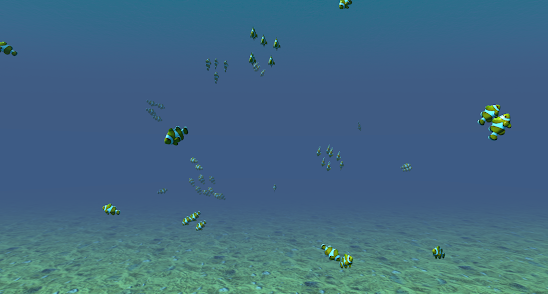Project Specification - Oh-fish-ial business
Jakob Arvidsson - jakarv@kth.se
Emilia Rosenqvist - emiros@kth.se
William Nilsson - wnil@kth.se
Grade Target
A-E
Background
In order to simulate flocking and cohesion behaviors in animal populations, an artificial life program was developed to simulate the behaviors [1]. This program used the notion of each individual in a population having an individual drive based on their own interests and goals based on three fundamental driving forces to simulate the desired behavior. These are the forces of separation, keeping individuals from getting too close, alignment, keeping individuals oriented in the same general direction, and cohesion, keeping individuals within the flock. While the original program was developed specifically for birds, the same algorithm gives good results for flock behavior in other populations as well. One way to expand upon this is by introducing predators and prey which is discussed by [2] and [3].
Implementation
The 3D engine Unity will be used to create the scenario where an ecosystem of fishes and other aquatic species can interact with each other. Unity will primarily be responsible for loading models and rendering the scene with scripts implementing the desired behaviors through different forces. In order to accomodate for more fishes the neighbor method will be improved by using space partitioning to improve time complexity. This will also allow for more interactive simulations, like implementing predators/prey and simulating a more realistic ecosystem with food, reproduction and death under various circumstances. This will be done primarily through repellent and attracting forces that can be applied to the vectors of each fish to influence their movement. The ecosystem containing food, reproduction and death will also need to have various circumstances under which reproduction and death occur, and be implemented into the simulation for them to take effect. Food will need to be reintroduced into the simulation at various points and perhaps under specific circumstances in order to maintain the balance of the system.
Result
The project will result in a more complex simulation of the boid environment from lab 1 in KTH course DD1354. This includes supporting a larger number of fish, predators and prey. The simulation should also include a simple simulation of food, death and reproduction at minimum. The simulation will use the existing code base from lab 1 using the boid system to simulate flocking and implement additional behavior on top of the existing code.
Risks/challenges
The efficiency of the space partition could potentially become a performance bottleneck for the other extensions of the simulation we intend to implement. It may also become difficult to find reasonable parameters for how much certain forces should affect fishes with the amount of forces being added, as well as finding good ways to reintroduce more food and allowing population increase/decrease at reasonable rates in order to not overwhelm the ecosystem.
Extensions
Extensions will be implemented given enough time.
Introduce blocking geometry such as rock formations to the simulation.
Introduce more complex interactions between fishes, such as a more expansive food chain or relationships between species such as symbiosis.
Introduce other life forms such as algae or corrals that can increase or decrease food availability or other aspects of the simulation.
References
[1] Craig W. Reynolds. 1987. Flocks, herds and schools: A distributed behavioral model. SIGGRAPH Comput. Graph. 21, 4 (July 1987), 25–34. DOI:https://doi.org/10.1145/37402.37406
[2] M. Wagner, W. Cai and M. H. Lees, "Emergence by strategy: Flocking boids and their fitness in relation to model complexity," 2013 Winter Simulations Conference (WSC), 2013, pp. 1479-1490, doi: 10.1109/WSC.2013.6721532.
[3] Richards, Deborah, et al. "Evaluating the models and behaviour of 3D intelligent virtual animals in a predator-prey relationship." Proceedings of the 11th International Conference on Autonomous Agents and Multiagent Systems-Volume 1. 2012.

Kommentarer
Skicka en kommentar